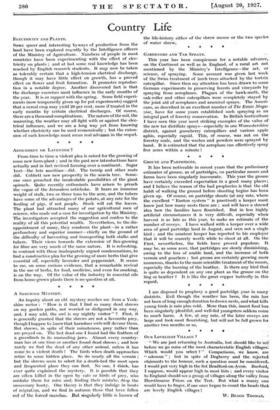ARTICHOKES OR LAVENDER ?
From time to time a violent plea is raised for the growing of some new farm-plant ; and in the past new introductions have actually and in fact revived farming over a continent. Sugar beet—the beta maritima—did. The turnip and other roots did. Cobbett saw new prosperity in the acacia tree. Some- one once preached the incalculable possibilities of the giant spinach. Quite recently enthusiasts have arisen to preach the vogue of the Jerusalem artichoke. It bears an immense weight of stalk, two or three tons to the acre, and the tubers have some of the advantages of the potato, at any rate for the feeding of pigs, if not people. Stock will .eat the leaves. The plant had attracted many of our agricultural men of science, who made out a case for investigation by the Ministry. The investigators accepted the suggestion and confess to the reality of all this potential wealth. Nevertheless, to the dis- appointment of many, they condemn the plant—in a rather perfunctory and superior manner—chiefly on the ground of the difficulty of harvesting and transporting both stalks and tubers. Their views towards the extension of flax-growing for fibre are very much of the same nature. It is refreshing, in contrast with these inadequately argued condemnations, to find a constructive plea for the growing of more herbs that give essential oil', especially lavender and peppermint. It seems to me, on some curious evidence, that a remarkable revival in the use of herbs, for food, medicine, and even for smoking, is on the way. Of the value of the industry in essential oils from home-grown plants there is no question at all.


































 Previous page
Previous page